This is a cross-post from Evolve Agility blog post.
A Systems modeling technique to visualize and act on deeply entrenched systemic issues.
Everyone carries a model, fuzzy as it may be, a map of sorts to navigate reality as perceived. As team members we have expectations from each other. This internal picture of our expectations, and reasons, and emotions, and all the mess that is being human is our mental model. The differences between what actually happens and what we expected it to be, reinforces our mental models or alters it. Learners are able to update their mental models more often, and thus adjust their actions and expectations with ever emerging reality.
I find that curiosity is the doorway to learning. Accumulation of knowledge on the other hand is founded on the mistaken belief that knowing about a thing is the same as knowing the thing.
By learning, I do not mean accumulation of knowledge or a collection of jargon to impress your colleagues. By learning, I mean understanding that enables you to take actionable steps in a very real practical sense.
Here I want to share an actionable technique that I have used to assist teams in learning together. But first, let’s acknowledge that everybody has a blind spot. No one at any time, not even once, can be all knowing.
Learning never stops, and this is the humbling truth. Mental models are at best approximations of reality, and can never be perfect.
As a hobby motorcycle rider, I constantly update my ‘model’ by continuously orienting myself to [sic]changes[sic] in road conditions, weather, other drivers on the road. We make up for lack of accuracy in our mental models by noticing these changes and adjust accordingly.
On the other hand, developing a perfect model will require that the rider account for every breeze, every pebble in order to develop an accurate picture of the situation at hand. And then take the next course of action. This as we know is analysis-paralysis. This affliction is detectable when people mistake knowledge about a thing, to knowledge of the thing. People who know about motorcycle maintenance talk more and do less, whereas actual mechanics talk less and do more.
We do not want to be bogged down with minutia, but act in response to emerging reality. A rider observes to validate or update their understanding of ground conditions. Additionally the rider continually scans/reorients to collect a good enough picture of emerging reality.
Never let your eyes fix on an object for more than two second, keep looking around. – Motorcycle rider manual.
Intense periods of concentrations may improve your resolution, but it comes at the risk of increasing your overall blind spot. If you have driven under snowy conditions, you know about the perils of tunnel vision. Focusing to appreciate each unique snowflake is not a recommended way to force an invitation to meet with your maker.
Without further ado, here are the steps to facilitation.
There is no learning without curiosity. So what are you curious about? I find that framing your curiosity as “I wonder…” opens people up to alternative possibilities, and perhaps awakes our inner playful inquisitive spark. Following are some examples:
Bring your curiosity to your team, and check for interest in exploring this topic further. Give up on knowing, and you will invite others to wonder together with you. ‘Just talk’ is best practiced as a relaxed conversation with your team members.
Remember everybody has blind spots. No one, not even you will have complete understanding. By ‘just talking’, you and the team members are exploring various factors that surround a topic.
We will use the first statement as an example for illustration.
I wonder why my team does not take on challenging work, or increase their productivity.
A brief 5-10 minute conversation within your team may yield the following related factors.

Related factors are often the ones that are perceived to change (increase or decrease) along with the topic at hand.
For example, in your ‘just talk’ session - you may have a talk about the situation when following a certain process step imposed by higher management leads to misunderstandings in team processes. You may capture this as two related factors “higher management process mandates” and “team understanding of management processes”, or as I have expressed above “team has autonomy over processes”. Fewer factors is better, and best not to get bogged down with wordsmithing.
CAUTION: These are by no means the only possible factors. And in your discussions within your team there will very likely be a different set of factors.
Within a team, each member has their own blind spots, but collectively the diversity within a cross-functional team will allow team members to cover for each other’s gaps in understanding.
Expect that different members in the team will have different degrees of sensitivities, and therefore you may find more than a handful of factors.
While it may be tempting to acknowledge everyone’s sensitivities on this matter, trying to consider too many factors at once will lead to analysis-paralysis. And our goal in this exercise is to be actionable
CAUTION: From the superset of related factors, select no more than eight factors. Fewer than four and you may not have considered the diversity of factors, and more than eight (or perhaps ten) and your collective efforts will remain stuck in analysis-paralysis.
As a team you can collectively agree on top eight factors, or use a prioritizing technique, such as dot-voting, to select factors that closely correlate with the subject of your team’s curiosity.
In our example, we have selected the following eight factors.
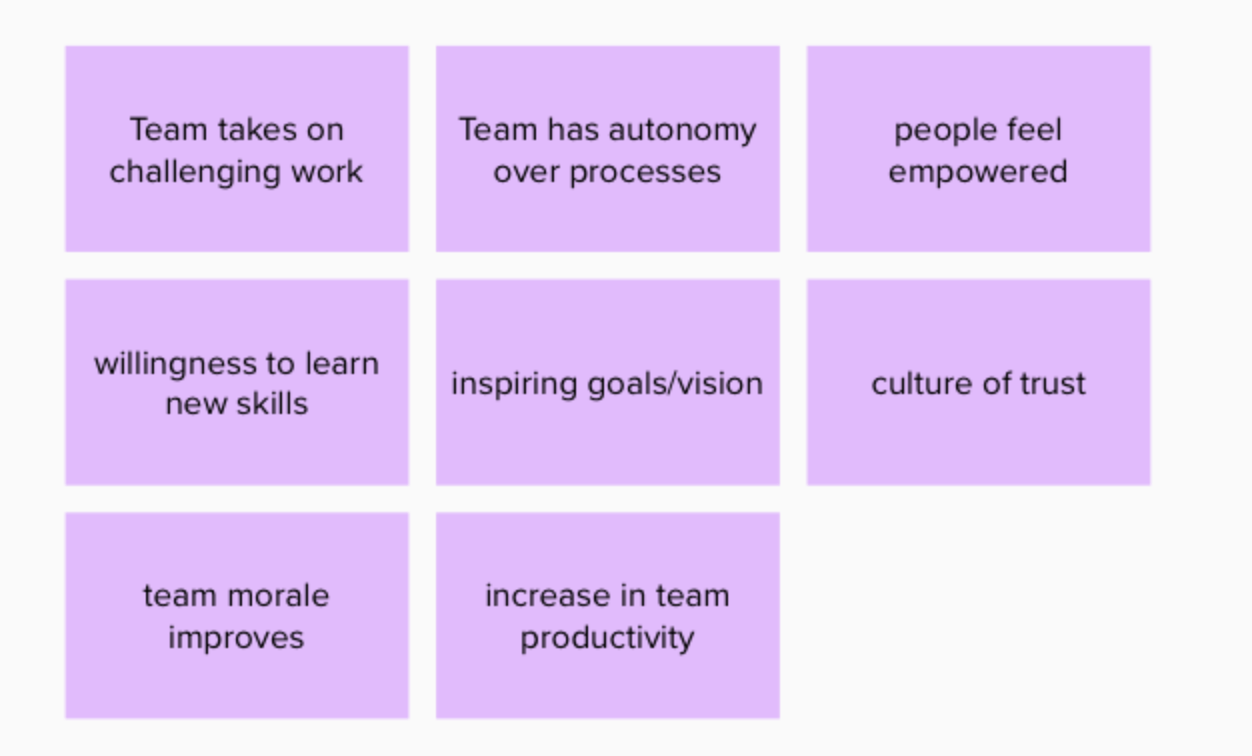
Organize your items on a physical/digital whiteboard so that items together form a large enough circle, with the items arranged roughly on the hour positions of a clock.
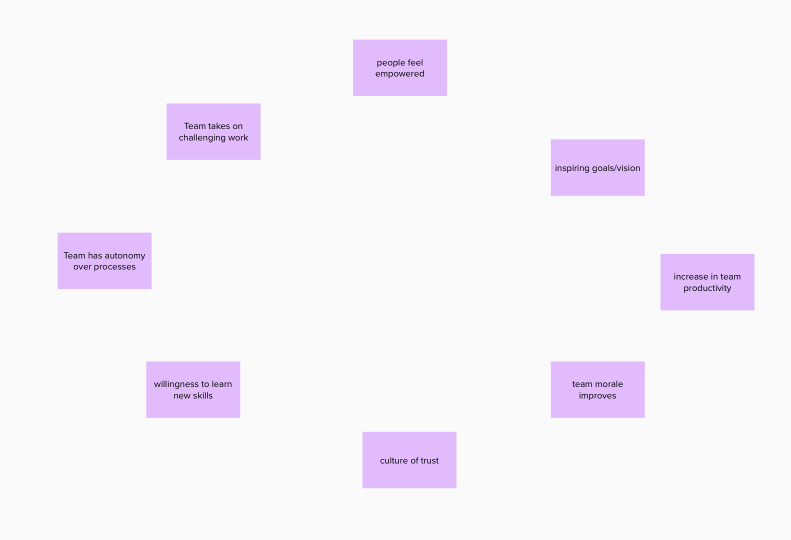
This step is best performed by randomly selecting one of the eight or so factors, and placing these randomly on the hour positions. Avoid unnecessary analysis.
I strongly recommend that you have a facilitator for this step. During the next analysis step, your team will dive into the relationship between selected factors. A dedicated facilitator will
The facilitators primary concern is to avoid analysis-paralysis, which merely leads to accumulation of knowledge, but no practical understanding that enables action.
The facilitator focuses on group interactions for remaining steps, and does not contribute in any other way.
The facilitator will invite team members to discuss relationships between sticky notes. The facilitator invites discussion within the team by posing a question:
“Is it because of [cause] therefore [effect] ?”
This is by far the most tedious step in this process, and takes a while to get comfortable with. As a facilitator you will need to use this phrase over and over again. By repeating the same sentence structure you are refraining from undue influence, and establishing a pattern for others to know when you are inviting discussion to consider the next relationship.
(a) Is there a cause-effect relationship? and which way?
Starting with the first sticky note item at the 12 O’clock position, the facilitator will ask the rest of the team to check for simple cause & effect relationships:
“Is it because people feel empowered therefore we have inspiring goals/vision ?”
AND then, after a brief pause check for causality in reverse:
“Is it because of inspiring goals/vision therefore people feel empowered ?”
By checking for directionality of cause and effect in both ways, your team may quickly discover the nature of the relationship between the two sticky notes (factors)
- OR -
conclude that these factors are not directly influencing each other.
In the example above your team may agree that inspiring goals/vision make them feel empowered.
(b) Is there a dominant direction?
Now keeping the same sticky note at 12 O’clock position as the anchor item, and moving clockwise, the facilitator will ask the team to check for relationship between the anchor item and the next in line factor:
“Is it because people feel empowered therefore increase in team productivity ?”
AND then, after a brief pause check for causality in reverse:
“Is it because of increase in team productivity therefore people feel empowered ?”
While the team is analyzing the relations, the facilitator must avoid getting dragged into their considerations. The facilitators role is to prevent analysis-paralysis from taking hold. While facilitating, ask the team members to pick one directionality as dominant.
DO NOT ALLOW FOR A RELATIONSHIP BETWEEN FACTORS TO BE BIDIRECTIONAL.
I say this with extra emphasis, not because bi-directional relationships do not exist, but because opening the exercise to also consider bi-directionality will confuse matters in the long run, and will get in the way of being actionable.
So when your group thinks that there is bi-directional relationship between two factors, pick one direction that is more likely or truer for your specific case.
In the example above, your team may find that when people feel empowered the productivity of the team improves as the more dominant relationship. Although it may also be true that when the team is productively humming, its sense of empowerment improves.
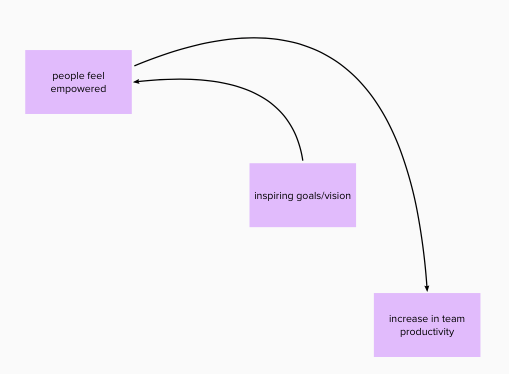
(c) Round robin
Keeping your 12 O’clock factor as the anchor, check for cause-effect relationship with remaining factors. Once your team has considered the relationship between the anchor factor “people feel empowered” with remaining factors, you will go through the same process all over again.
This time, you will move clockwise and select the factor at 2 O’clock position to be the anchor item. Since we have discussed the relation between the new anchor and the previous anchor, we will have one less relationship to discuss.
After cycling through anchor #2, you will select the next in line anchor moving methodically in clockwise fashion. Each time you cycle through, there is one less relationship to discuss. Until finally there is only one relationship to discuss between the seventh anchor and the eight factor.
Hence, my caution in step 3 above to limit the number of factors to a maximum of eight.
This analysis is essential. By exploring cause-effect relationships, the team is collectively forming their shared mental model of factors and relationships between them.
You may end up with a map of cause and effect relationships like this.
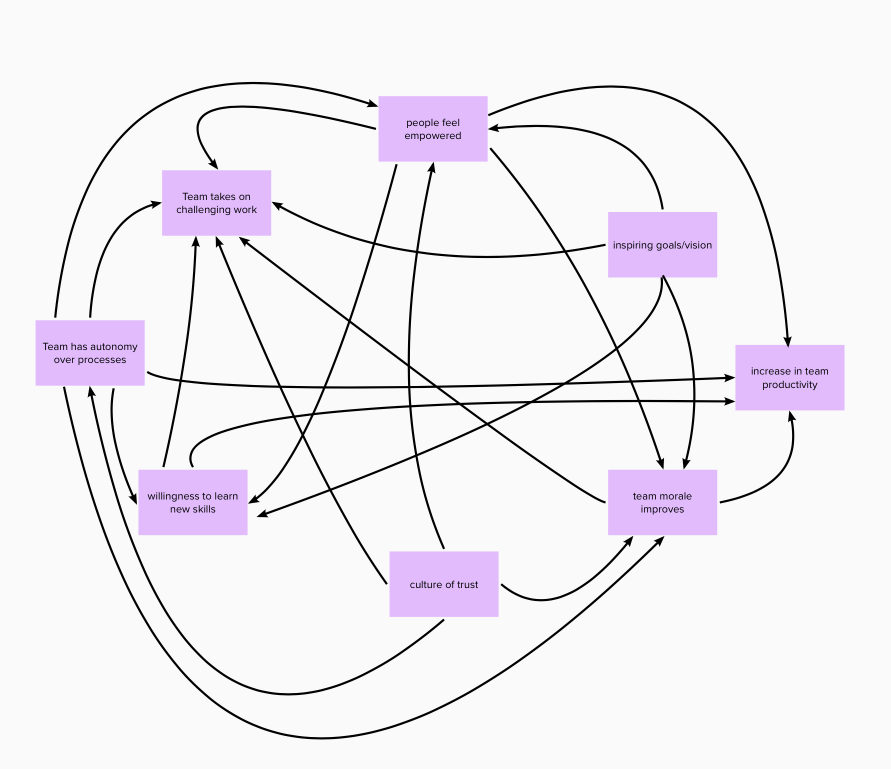
(d) You can not present this
This messy ball of relationship yarn, must be confusing to you. Just as it should be. You were not involved in the discussions that led to it. This diagram would mean as much to you as it does to a playful kitten. Something to toy around with, and perhaps to get entangled in a cute mess with.

The value of Simple cause and effect analysis lies in enabling structured conversations within the team. This is an approximation, at best, of shared understanding of the context within which this team operates. The hidden systems structure that governs observable behaviors and events. This visual representation means a lot to the team members who participate in its creation. It provides a reference for all team members to visualize together. A snapshot of how team members intuit their organization system to really work. How cool is that!
Curiosity (I wonder…), and participation (engagement) are prerequisites to understanding. You cannot present this model. It will make no sense to your manager or your friend. They will have to engage in a conversation with your team and influence the shape of this shared mental model. And as a consequence they will share their learning with others, to increase overall team awareness. Therefore, I strongly encourage managers to participate and wonder along with their teams.
The services of a facilitator are crucial. Their patience, and methodical channeling of discussions to keep momentum helps a team to not get bogged down in minutia. With practice, Step 6 - Simple cause and effect takes 15 - 20 minutes.
But the facilitator’s role is not done yet. The best is yet to come.
Learning together as a team involves owning your insights and taking actions based on them. You cannot borrow these insights from the “best practices manual”, and no tool is a substitute for judgment. As a team you will have to arrive at your own insights, and take action based on your own understanding.
In complex systems, any system that involves people, there is never really a single cause nor a real single effect. Things are interconnected, and in surprising ways. With the simple cause and effect diagramming above, our objective is not to play post-it billiards. Instead we want to develop a shared understanding by considering the system as a whole. There are revealing insights in the picture above, if you know how to look for it.
For each factor count the number of arrows going out, and the number of arrows coming in.

A quick reminder on our curiosity that led us here:
I wonder why my team does not take on challenging work, or increase their productivity?
Reviewing our counts reveals that the system as modeled, through team conversation, has the following dominant effects:
Nothing terribly surprising here. Of course since the manager and/or the team is curious about lack of initiative from the team in taking challenging work and wants to increase productivity, we are now assured this is indeed a visible outcome of this systems structure.
Everybody sees the dominant effect, and worries about it. Visibility attracts attention. And as a consequence of attracting attention, it gets measured. Any real or perceived lack of meeting expectations, or desire to showcase improvement will draw attention to this most visible factor. The dominant effect.
Managers may rush to create a team member skills competency matrix so they can hold them individually accountable. Or hold a team meeting to set expectations on the number of story points/breadth expectations from the team. Such interventions are easy to announce, and may show marginal improvement in the short term. And therefore, perhaps, these continue to be tried over and over again.
Such interventions are naive, because they work against systemic leverage. Understanding points of leverage within your system and directing interventions appropriately can unlock long term shifts.
A quick review of our counts reveals that the system as modeled, through team conversation, has the following dominant causes:
Notice that I am ignoring factors that have almost the same number of arrows IN and OUT.
A dominant cause is one that affects many factors directly or via other factors. Interventions aimed to make desirable shifts in dominant causes hold more promise.
Dominant causes often become entrenched and hidden. They can be hard to pin down. And this is why we have gone through all the steps so far - so the system at play can reveal its secrets.
Systems modeling is a collective activity for the whole team, and not for a manager alone. Through modeling, team discussions, and visually representing a shared model, your team will unlock additional insights that could hold revealing breakthroughs to make shifts at these crucial points of leverage.
For our purposes, we will go through the example discussed to consider some practical steps that can be taken by a team. These may not be applicable to your specific situation.
Building a culture of trust can be a humongous task when considered at the scale of a corporation. But at the same time building pockets of trust may be feasible within a single team. What can team members do to improve trust between themselves and with their managers ? Your team may start holding retrospectives again or take time out to socialize over virtual lunch. For an example of technique that I have used, see sharing values exercise to improve the degree of trust within your sphere of influence.
Managers may also consider easing down on prescriptive ways or, even better, set up a decisions agreement with their team, see decide how you are going to decide, so the team and management can have explicit agreements in areas where the team has autonomy over its processes.
Understanding the points of leverage for your system at play can open up a wide array of possibilities. A tiny change at these points of leverage can have disproportionate (non linear) impact on the overall system dynamics.
Get creative. Mix and match to design counter-measures that make a tiny dent across multiple factors, or consider a set of related counter measures to be tried all at once.
Because the dominant causes are so entrenched, they may not easily budge. And so, paradoxically, attempts to influence dominant causes lead to safe-to-fail experiments. Because big changes cannot be tried at once, you have to take incremental steps. And also because no one expects you to actually tip the system, you have the advantage of attempting multiple creative interventions.
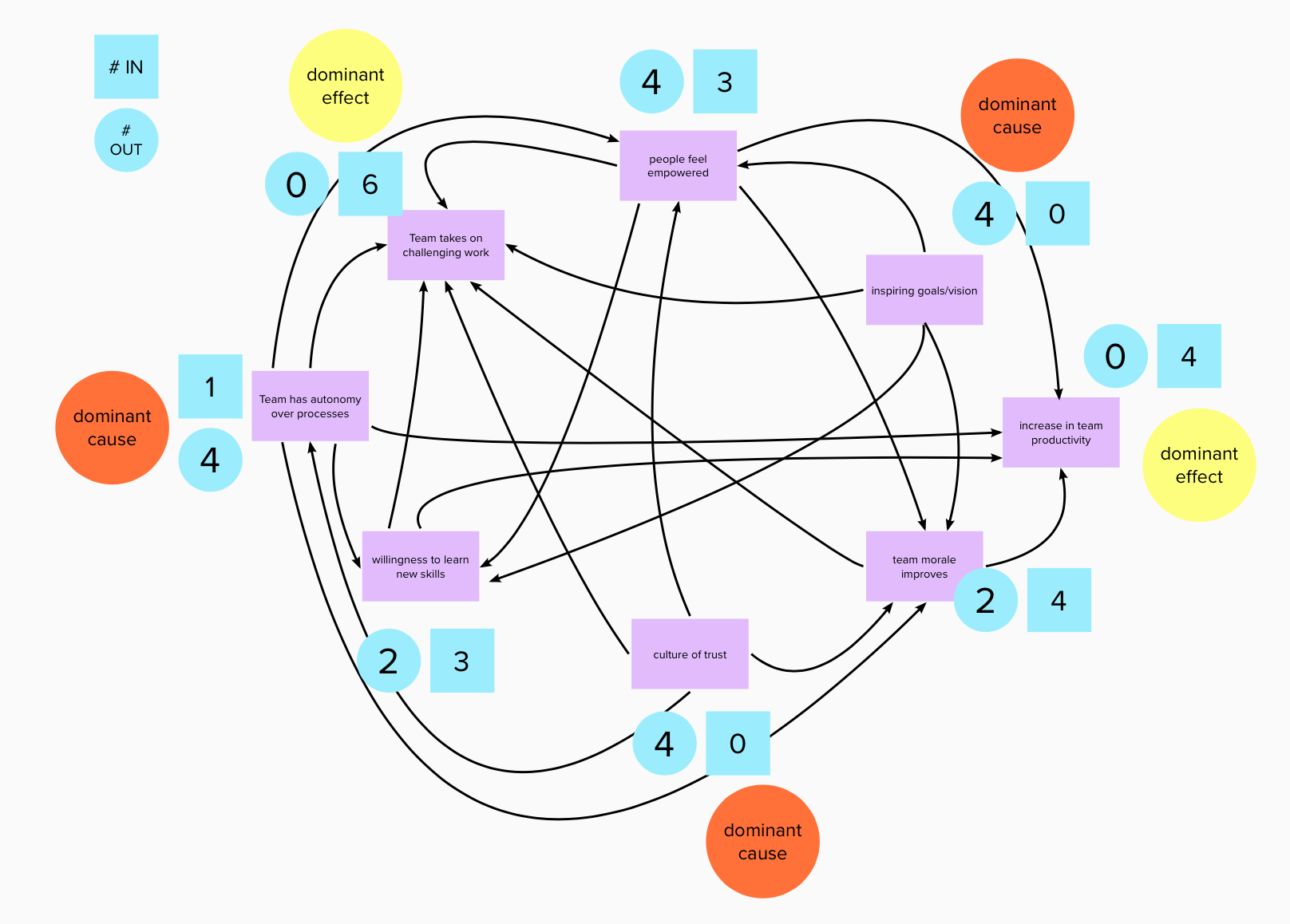
Of course there is no way we can model all the factors that are involved. Remember everybody has their blind spots.
Clearly there must be some other factors that cause changes to “culture of trust” and “inspiring goals/vision”. Just because in our systems diagram there are no factors that affect them, it does not mean that there are no other factors that affect these dominant causes.
Our understanding of factors itself will also also be incomplete. Of course a culture of trust is not the only factor that affects a team’s autonomy over its processes. There may be instances where we collectively modeled incorrectly, or failed to notice a relationship that actually in fact exists. These are our collective blind spots.
These boundaries of comprehension and understanding are our limits. Teams benefit from keeping this visualization so that the shared systems model can be easily updated.
There is no way one can consider the totality of everything involved to make the best decision. Courage to act from incomplete understanding is foundational to team learning. And this simple cause and effect systems modeling technique can aid your team to collectively build shared understanding of your system at play. So you can decide and agree on what to do about it.
I wonder…
Learning never stops. After attempting this activity in your first area of concern, you will undoubtedly uncover new areas of inquiry.
My hope is that managers and leaders open doors to team learning through their example of practicing curiosity, engaging in collective learning and boldly attempting counter-measures to some of the deeply entrenched issues of the modern work environment.
If you found this article useful, join our Accelerate Advantage™ mailing list. Evolve Agility is founded on the belief that people care deeply about their places of belonging and are not afraid to take action. Join our mailing list to stay connected with a growing community of practitioners who believe in actionable learnings.